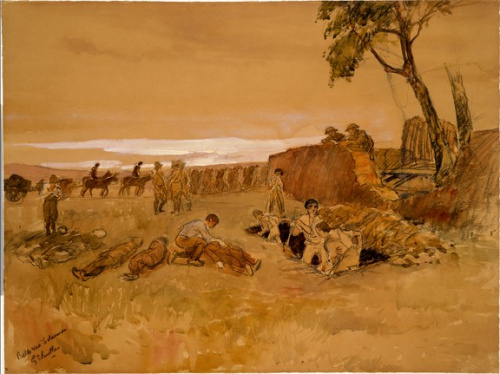THE WAR ARTIST
17/04/2020 - 31/05/2020
COVID-19 Lockdown Festival 2020
Production Details
about 88 years ago
Inspired by the work of New Zealand’s first official war artist, George Butler. Butler is attached to a small burial party charged with taking an ambulance full of corpses and finding a suitable spot for burial. Butler is confronted with the role luck plays in a soldier’s life.
Cast: Tim Spite, Jack Sergent-Shadbolt, Alex Greig
What’s the validity of creating art in the face of war?
Both poignant and humorous, The War Artist by Carl Nixon explores that very question. The play is a two-part drama based on New Zealand’s first official war artist George Butler and was specifically inspired by Butler’s painting Burial Party at Bellevue near Solesme.
Nixon stumbled upon George Butler’s work. “Butler sketched many striking and sombre images in the final months of The Great War, but the one that caught my attention was Burial Party at Bellevue Near Solesme. I printed out the image and wrote next to it ‘here is the play!’ How amazing that an artist sat and sketched men digging a mass grave to bury their New Zealand comrades – and so far from home. What is the point of such a piece of art, I wondered? Can it possibly help or even have a place in the face of four years of mechanised slaughter? Who were the men digging the grave and how did they feel? Numb, dazed, angry, nothing at all?”
See other examples of Butler’s WWI art in our George Butler Gallery
Theatre , Audio (podcast) ,
33 min + 37 min
Finely-wrought
Review by Barbara Frame 17th Apr 2020
The war artist is a real person: George Butler, who in 1918 joined the New Zealand Expeditionary Force tasked with painting the NZEF’s work, presumably with an expectation that the force would be represented in a positive way.
Nearly a century on, playwright Carl Nixon takes Butler’s Burial party at Bellvue near Solesmes as a starting point. In the painting’s foreground, soldiers dig graves to bury five corpses: one of the soldiers appears to be going through the pockets of the dead. Nixon inserts the artist into his own painting by making him a participant in what happens. In Radio NZ’s production he’s played by Tim Spite. The other characters are Sergeant Fenton Price (Alex Grieg) and Private Bob Mitchell (Jack Sergent-Shadbolt).
The action in Part 1 largely consists of grave-digging while dialogue reveals the three men’s pasts and temperaments. Butler, conventionally religious and more at home painting portraits and landscapes than trying to render ghastly scenes in an aesthetically acceptable way, is clearly uncomfortable in his military role. Both Price and Mitchell have been soldiers for years and have seen war at its worst: Price has had to suppress his artistic tendencies but still retains his humanity, while Mitchell’s battle-weary bravado is insolent and often offensive.
In Part 2, tensions between Price and Mitchell escalate when one of the bodies is found to be that of a German soldier: should he be buried in the same grave as the New Zealanders? The dilemma is solved in a quick-and-dirty manner that’s definitely not the kind of thing powers-that-be would want to be part of war heritage.
Further conflict arises when another body turns out to be that of Price’s brother, and here Mitchell’s automatic derision stokes Price’s grief. Butler, meanwhile, attends to his instructions to “look for magnificence” in what he sees.
“You can’t see what we’ve been through in a picture,” says Mitchell at one point. Maybe you can – but here we meet, head-on, the paradox of the war artist’s job. He’s in the action but barely part of it, and his job is to do something unpleasantly situated between recording and propaganda, producing work that justifies and even glorifies the very nasty stuff that he sees happening. Should horror be preserved, or wilfully forgotten?
It’s comparable to the way in which Price’s brother’s death is later reported: in accordance with convention, the family is told that he died instantly and did not suffer. Listeners may also consider the plight of modern embedded war journalists who are required to tell a version of the truth, rather than the truth.
The War Artist is a finely-wrought, affecting contribution to the collective oeuvre of New Zealand playwrights’ work on the First World War and our country’s experience of it.
Copyright © in the review belongs to the reviewer





Comments